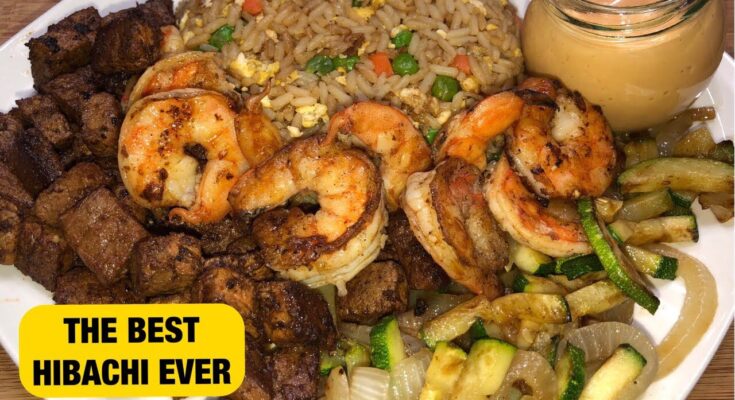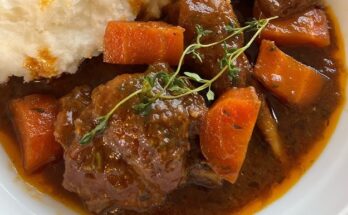Hibachi Recipe: Hibachi cooking is more than just preparing food—it’s a captivating culinary art that combines flair, flavor, and fun. Originating from Japan, the Hibachi style has evolved into a global dining experience. Whether you’ve seen skilled chefs flipping shrimp tails into their hats or dazzling with onion volcano tricks, Hibachi is an unforgettable way to enjoy a meal.
In this guide, we’ll dive into everything you need to know about creating a mouthwatering Hibachi recipe at home. From ingredients to techniques, you’ll learn how to recreate this restaurant-style meal step by step.
Ingredients Required for Hibachi
Protein Options
One of the best things about Hibachi is its versatility. You can choose from chicken, shrimp, steak, or even tofu for a vegetarian option. Here are some tips:
- Chicken: Opt for boneless, skinless chicken thighs or breasts. They cook quickly and absorb flavors well.
- Shrimp: Use peeled, deveined shrimp for convenience. Tiger or jumbo shrimp work best.
- Beef: Tender cuts like ribeye, filet mignon, or sirloin are ideal for Hibachi cooking.
- Vegetarian Options: Tofu, tempeh, or seitan can be seasoned and cooked similarly to meats.
Vegetables Used in Hibachi
Hibachi vegetables are a colorful medley of freshness and flavor. The most commonly used vegetables include:
- Zucchini
- Mushrooms
- Carrots
- Broccoli
- Onions
- Bell peppers
Chop these into bite-sized pieces to ensure even cooking. A mix of crunchy and tender vegetables adds to the texture of your dish.
Hibachi Rice and Noodles
- Rice: Use day-old jasmine or long-grain rice for the best fried rice. Freshly cooked rice tends to clump.
- Noodles: Udon noodles are commonly used in Hibachi dishes due to their chewy texture. Lo mein noodles are a good alternative.
Essential Sauces and Seasonings
The sauces and seasonings are what make Hibachi distinct:
- Soy Sauce: The foundation of Hibachi flavor
- Garlic Butter: Adds richness to proteins and vegetables
- Sesame Oil: Infuses a nutty aroma
- Ginger Sauce: Perfect as a dipping sauce
- Yum Yum Sauce: A creamy, tangy topping beloved in Hibachi dishes
Tools and Equipment for Hibachi Cooking
To achieve authentic results, invest in the right tools:
- A flat-top griddle or a large cast-iron skillet
- Metal spatulas for flipping and mixing
- A squeeze bottle for oils and sauces
- A sharp knife for precise cutting
Preparation for Hibachi Cooking
Prepping the Ingredients
Proper preparation is the key to seamless Hibachi cooking. Follow these steps:
- Marinate the Proteins: Marinate chicken, shrimp, or beef in a mix of soy sauce, sesame oil, and garlic for at least 30 minutes.
- Cut the Vegetables: Chop vegetables into uniform pieces for even cooking.
- Cook the Rice in Advance: Use cold, day-old rice for Hibachi fried rice.
Setting up Your Cooking Space
Organizing your workspace ensures smooth execution. Arrange your ingredients, tools, and sauces around the griddle for easy access. This setup mimics the efficiency of professional Hibachi chefs.
The Importance of Timing and Heat Control
Hibachi cooking requires precise timing and heat management. Preheat your griddle to medium-high heat and ensure each ingredient gets the proper cooking time.
Cooking Techniques for Hibachi
Searing Proteins to Perfection
Begin with your proteins:
- Heat the griddle to high heat.
- Add garlic butter and sear the proteins until golden brown. Flip and cook through.
Stir-Frying Vegetables for Optimal Flavor
Vegetables in Hibachi cooking are known for their perfect balance of tenderness and crunch. Here’s how to achieve that:
- Heat sesame oil on your griddle or skillet.
- Add onions first as they take slightly longer to cook.
- Gradually add carrots, zucchini, mushrooms, and broccoli, stirring frequently.
- Toss the vegetables with soy sauce and a dash of garlic butter for flavor.
The goal is to keep the vegetables bright and slightly firm, not mushy. This combination of textures elevates the dining experience.
Perfecting Hibachi Fried Rice
Hibachi fried rice is a fan favorite and surprisingly simple to prepare. Follow these steps for a restaurant-quality result:
- Push cooked proteins and vegetables to the side of the griddle to make space.
- Add cold, cooked rice to the center and drizzle sesame oil over it.
- Toss the rice continuously to coat it with oil and break up clumps.
- Crack an egg onto the griddle and scramble it into the rice.
- Add soy sauce, garlic butter, and a pinch of salt, mixing well.
The key to authentic Hibachi fried rice is using cold rice and high heat to develop a slightly crispy texture.
Making Hibachi Noodles
Hibachi noodles are chewy, flavorful, and the perfect accompaniment to the meal. Here’s how to make them:
- Cook udon or lo mein noodles according to the package instructions. Drain and set aside.
- Heat sesame oil on the griddle and add a mix of soy sauce, sugar, and garlic butter.
- Toss the noodles in the sauce mixture, ensuring they’re evenly coated.
- Stir frequently until the noodles are heated through and slightly caramelized.
Serving and Presentation
Plating Tips for a Restaurant-Like Experience
Presentation matters as much as the taste. Arrange the cooked proteins, vegetables, rice, and noodles neatly on a plate. Use the following tips to elevate the look:
- Serve the rice in a small, rounded mound by packing it into a small bowl and inverting it onto the plate.
- Garnish the dish with sesame seeds or chopped scallions for a professional touch.
Pairing with Dipping Sauces
No Hibachi meal is complete without sauces. Offer small bowls of ginger sauce and yum-yum sauce for dipping. These add layers of flavor and allow guests to customize each bite.
FAQs about Hibachi Recipe
What is hibachi cooking?
Hibachi cooking is a Japanese method where food is cooked on a high-heat metal cooking plate. Traditionally, ‘hibachi’ refers to a heating device rather than the style of cooking, but it has become synonymous in many places with a style of Japanese cooking that is simple, quick, and engaging.
What ingredients do I need for a basic hibachi recipe?
A basic hibachi recipe typically includes rice or noodles, vegetables such as onions, zucchini, and mushrooms, and protein like chicken, beef, or shrimp. Key seasonings include soy sauce, sesame oil, garlic, and ginger.
Do I need a special grill to make hibachi at home?
No, you don’t need a traditional hibachi grill to make hibachi-style food at home. A large flat skillet or a frying pan can work well. The key is to cook on high heat to replicate the quick-cooking environment of a hibachi grill.
How can I make my hibachi rice taste like it does at restaurants?
To make hibachi rice taste like it does in restaurants, use cooked, cooled rice, and high heat for frying. Adding butter, soy sauce, and a bit of sesame oil can enhance the flavor. Some recipes also include eggs, chopped vegetables, and a hint of sugar for added taste.
What are some common sauces to serve with hibachi?
Popular sauces for hibachi include soy sauce, ginger sauce, and the creamy, slightly spicy Yum Yum sauce. Each sauce offers a different flavor profile to complement the smoky, savory notes of hibachi-cooked food.
Is hibachi cooking healthy?
Hibachi cooking can be very healthy as it often involves a lot of vegetables and lean proteins. The use of high heat for a short time helps to retain nutrients and flavors. However, watching the amount of high-calorie sauces and oils can help keep it healthier.
Conclusion
Making Hibachi at home is an enjoyable experience that brings the excitement of the teppanyaki grill into your kitchen. With the right tools, fresh ingredients, and these step-by-step instructions, you’ll be able to recreate the magic of Hibachi dining effortlessly. Customize your meal with your favorite proteins, vegetables, and sauces, and let your creativity shine.



